Page last updated: January 2024
The information on this webpage was adapted from Breast Prostheses and Reconstruction (2023 edition). This webpage was last updated in January 2024.
Expert content reviewers:
- Dr Jane O’Brien, Specialist Oncoplastic Breast Cancer Surgeon, St Vincent’s Private Hospital, VIC
- Clare Bradshaw, Clinical Nurse Consultant, Breast Assessment Unit, Fiona Stanley Hospital, WA
- Rene Hahn, Consumer
- Sinead Hanley, Consumer
- Dr Marc Langbart, Specialist Plastic and Reconstructive Surgeon, Randwick Plastic Surgery, NSW
- Melanie Law, Consumer
- Sally Levy, Consumer
- Annmaree Mitchell, Consumer
- Ashleigh Mondolo, Breast Cancer Nurse Clinical Consultant, Mater Private Hospital Brisbane, QLD
- Rochelle Osgood, Clinical Nurse Consultant – McGrath Breast Care Nurse, Sunshine Coast University Hospital, QLD
- Dr Kallyani Ponniah, Head of Department, Breast Centre, Sir Charles Gairdner Hospital, WA
- Meg Rynderman OAM, Consumer
- Sarah Stewart, Breast Care Nurse, The Royal Women’s Hospital, VIC
- Erin Tidball, 13 11 20 Consultant, Cancer Council NSW
- Jane Turner, Senior Exercise Physiologist, Sydney Cancer Survivorship Centre, Concord Cancer Centre, NSW.
First weeks after surgery
In the first weeks after surgery, you may want to wear a temporary breast prosthesis called a soft prosthesis (or soft form). The soft prosthesis is light and made from a smooth material such as polyester. It can be worn in a bra that has a pocket (post-surgical bra).
Choose a bra with a front opening to avoid stretching your arms behind your back, as this can be uncomfortable. If the bra feels too tight or rubs against your scar, you can wear a crop top or camisole with a pocket in it. You can also wear a soft prosthesis while your skin is tender from radiation therapy.
You can be fitted for a permanent prosthesis when the skin and other tissue has healed. This may be up to two months after surgery and six weeks after radiation therapy. Check with your surgeon or breast care nurse about how long you need to wait.
My Care Kit
Breast Cancer Network Australia (BCNA) provides a free bra and temporary soft form for use after breast cancer surgery. The bra is designed to be worn immediately after surgery. It has seams that avoid pressure on scars, and extra hooks and eyes to adjust the bra for any swelling. It can also be done up from the front or back, making fastening easier. To order a My Care Kit, speak to your breast care nurse.
Learn more
What to consider - breast prostheses
|
|
Benefits
|
Drawbacks
|
- Can give you the look of two breasts under clothes.
- Avoids the risks of surgery and extending the recovery time, which makes it possible to return to daily activities faster.
- Can be worn with different clothes, including during sports such as swimming.
- Medicare covers part of the cost of a new or replacement prostheses.
- Can be replaced if it wears out or is damaged.
- Can be worn while you're waiting for reconstructive surgery or during chemotherapy or radiotherapy treatment.
- Can be matched to your breast size to correct weight imbalance.
- Easy to change size (e.g. if the size of your other breast changes).
|
- You may not like the idea of having an artificial breast.
- You may need to wear a special bra to keep the prosthesis in place.
- Requires special washing and storage.
- You may need to make changes to your clothes or use accessories so the prosthesis stays in place.
- May be uncomfortable at times (e.g. heavy, hot or irritating), especially when playing sport or on hot days.
- You may be concerned the prosthesis will move or fall out.
- You may feel self-conscious when naked and not wearing the prosthesis.
- Needs to be replaced every few years.
|
Types of prostheses
As everyone is different, prostheses are available in a variety of shapes (triangles, circles or teardrops), cup sizes (shallow, average or full) and skin colours.
There are also partial breast forms (triangles, ovals, curves and shells) for women who have had breast-conserving surgery and want to regain breast symmetry. These are also called balance shapers.
Different prostheses have different amounts or layers of silicone. This allows you to match the breast prosthesis to the structure and movement of their remaining breast.
Symmetrical prostheses are even on both sides and can be worn on either the left or right side of the body. Asymmetric prostheses are designed specifically for the right or left side.
The type of prosthesis you can wear will depend on the amount and location of tissue removed during surgery. You should be able to find one that is close to your original breast shape and suits your lifestyle. Your fitter will be able to guide you through the range of prostheses that are suitable for you.
Material used in prostheses
Temporary soft prostheses
These tend to be made with foam, fibre fill or fleece. In the first couple of weeks or months after surgery, you will be given a temporary prosthesis to wear while you heal. Another option is to use the temporary soft prosthesis with a knitted cotton cover called a knitted knocker, which often includes the shape of a nipple. To order a knitted knocker, visit Knitted Knockers Australia.
You may find some temporary prostheses are more comfortable than others. Your breast care nurse can organise a temporary soft prosthesis for you. Once the area has healed, you can continue to wear the soft prosthesis at night-time.
Permanent breast prostheses
These are usually used long term and are mostly made from medical grade silicone gel. Silicone is a non-toxic manufactured substance that is heat-resistant and rubbery. If a prosthesis tears or punctures, the silicone can’t be absorbed by the skin.
The silicone is moulded into the shape of a breast or part of a breast. The front surface feels soft and smooth. The back surface, which rests against the body, varies depending on whether the prosthesis is designed to go into a bra pocket or attach directly to your skin. It can be firm and smooth; flat or hollow; have ridges that are soft and flexible; have a thin film that clings gently to the skin; or be made of fabric. A new type of prosthesis has an inflatable back that you can adjust for comfort.
Most permanent prostheses are weighted to feel similar to your remaining breast (if only one breast has been removed), but lightweight styles are also available. Some prostheses include a nipple outline, or you can buy a nipple that attaches to the prosthesis.
"Breast forms are very well designed these days. Anyone pressing up against you would not know the difference – not like the days when they were filled with bird seed or rice." – Jan
Different breast prostheses and their features
|
|
Prosthesis type
|
Soft
|
Three-layer |
Partial breast form |
Lightweight breast form |
Attachable or contact breast form |
Adjustable |
Swim breast form |
What the prosthesis looks like
|
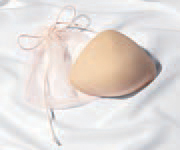
|
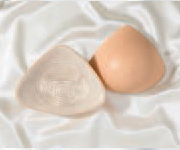
|
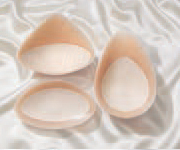
|
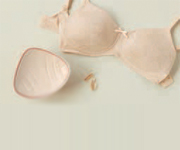
|
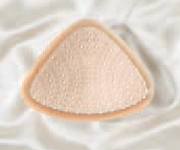
|
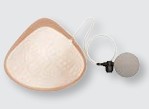
|
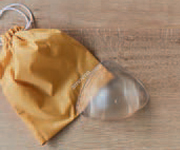
|
| When used |
Immediately after surgery; during leisure time or sleeping |
Everyday use |
After breast-conserving surgery or if breast changes shape after radiotherapy |
Everyday use |
Everyday use |
Everyday use |
When swimming |
| How used |
Worn in a pocketed bra |
Worn in a pocketed bra |
Can be worn in your usual bra cup |
Worn in a pocketed bra |
Attachable; adheres to the chest wall |
Worn in a pocketed bra |
Worn inside the pocket of a swimsuit |
| Material |
Polyester front cover and cotton back cover |
Three layers of silicone to help the prosthesis drape and move more realistically for the type of breast it is matching, such as a younger or an older breast |
Two layers of silicone |
Slightly firmer lightweight silicone in the back layer helps keep the prosthesis in place when worn in a bra pocket |
Standard silicone layer with super soft film |
Lightweight or ultra-lightweight silicone |
Lightweight pale blue silicone |
| Weight |
Lightweight |
Regular weighted silicone |
Regular weighted silicone |
Weighs 40% less than a standard silicone prosthesis |
Lightweight |
Weighs 40% less than a standard silicone prosthesis |
30% lighter than a standard prosthesis |
| Special features |
Breathable cotton back layer to maintain ideal body temperature |
May include technology to maintain ideal body temperature |
Extra soft silicone, covered with a
thin film to cling gently to the breast with temperature-regulating technology |
Back layer includes temperature-regulating material; available in different colours |
Designed with a low- cut inside edge for use when surgery has conserved a small area of cleavage |
Has a built in air chamber that you can adjust to ensure a close fit and good skin contact |
Resistant to salt water and chlorine; quick drying |
| Other considerations |
Not a suitable substitute for a weighted silicone form that provides body with balance |
Symmetrical shape – can be worn on either the left or right side |
Available in a variety of shapes and sizes to replace the missing breast tissue and to achieve symmetry |
Designed to drape like a natural breast so that it moves with the body and flattens when you lie down |
Follows body movements naturally; suits figure-hugging clothes |
Provides comfort if your chest wall is uneven |
Water moves behind the prosthesis to make it more comfortable |
Buying a breast prosthesis
To find a prosthesis that suits your body shape and frame, it is recommended that you see a trained fitter who can help you choose the right prosthesis, as well as a pocketed bra if necessary. It is best to make an appointment with a fitter so you have uninterrupted time with them.
You can visit a store to buy your prosthesis, or you may feel more comfortable organising a home fitting. You might like to bring along someone for support – the other person doesn’t have to come into the dressing room with you.
You might find getting fitted for a prosthesis to be an emotional experience, especially the first time. You may feel embarrassed at the thought of having someone else see the site of the surgery. Professional fitters regularly see women who have had similar surgery and will take a sensitive approach.
Before your appointment (or even before your operation), you may find it helpful to see samples of breast prostheses to give you an idea of what to expect. Your breast care nurse can show you various types of breast prostheses and bras. You may also find it useful to talk to someone who is using a breast prosthesis – see information about volunteer peer support.
"It's like buying anything valuable. You need to take your time and make sure it's right." – Mary-Anne
Where to buy a breast prosthesis
You can buy a breast prosthesis from specialist stores that sell only breast prostheses and related products, the lingerie section of some major department stores, and lingerie boutiques. There may also be a free home service available in your area.
If you live in a rural area, you might have fewer options for what you can buy and where you can shop. Making a trip to a shop in a large town or city may be worthwhile. This might also appeal if you don't want to shop where people know you.
You can also browse online or ask retailers to send catalogues so you can look at the full range of bras and breast prostheses available. If you see something you like, you may be able to order it, or a fitter can order it in for you. However, it is recommended that you see a fitter to be measured in person, particularly if you are buying a breast prosthesis for the first time.
Ask the store about its returns policy. You may be able to exchange the breast form for a different style or size if the one you buy feels uncomfortable. However, this is not always possible, particularly for attachable breast prostheses.
Call Cancer Council 13 11 20 for a list of stores where you can purchase breast prostheses and related products. You can also use Breast Cancer Network Australia's local service directory to find a specialist prosthesis fitter in your area.
At the fitting
A fitting usually takes 40–60 minutes. You will have privacy when being measured and getting changed. See a list of questions you might like to ask your breast care nurse or a breast prosthesis fitter. Most fitters carry out the fitting in a similar way:
- Take the bras you wore before surgery to the fitting. The fitter will check whether these bras are suitable to use with a prosthesis.
- The fitter will probably check your existing bra size with a tape measure.
- If you've had a double (bilateral) mastectomy, the fitter will ask you what breast size you were and what size you would like to be. You might like to keep your original size or go up or down a size. The fitter will ask you about what type of bras you like and how active you are.
- The fitter will bring you a selection of pocketed bras to choose from. While you may find that your regular bra, sports bra or sports crop top adequately supports your permanent prosthesis, pocketed bras are specially designed for this purpose.
- When you've chosen your bra, the fitter will help you try on several breast prostheses until you find a good fit.
- The fitter often has a slip-on T-shirt (like a smock) for you to try over the bra and prosthesis to check that the form is the right size and gives you a good shape.
- The fitter shows you how to check the breast prosthesis sits properly in the pocketed bra, and will discuss how to take care of it.
Common concerns
It may take time to get used to having a prosthesis. You may feel nervous about wearing it, or it may feel different depending on the weather, your clothes or what you're doing. Common concerns include:
Temperature
You may find that wearing the prosthesis feels too hot in warm and humid weather. This is more common if you have larger breasts. New models of breast forms are designed with air ventilation and drying methods to help manage temperature and increase comfort.
How to control the temperature
- Wear a correctly-fitting bra to hold the prosthesis in the right place and help keep you cool.
- Buy a breast prosthesis that uses temperature-regulating technology. This helps absorb body heat and helps maintain your body temperature.
- Wear a lightweight prosthesis in warmer weather, which may keep you cooler.
- Use a bra pocket or a breast prosthesis cover with a regular bra to help absorb sweat (perspiration) and keep you cool on hot days. Check whether your fitter supplies covers.
- Wear a bra made with fast-drying or sweat-wicking fabric, such as a sports bra. This may be more comfortable if you perspire a lot.
- Wash your prosthesis well at the end of the day to stop any perspiration from degrading the prosthesis.
- Choose clothing made with cool, comfortable fabric, such as linen, silk or a synthetic fabric that is breathable.
"My breast form gets sweaty after I've been playing tennis. I have two, so after a shower I swap." – Pam
Weight
Silicone prostheses are available in different weights to accommodate a variety of needs. A standard silicone breast prosthesis is designed to be about the same weight as the other breast. Lightweight and ultra-lightweight breast prostheses are about 20–40% lighter than a standard prosthesis. You may prefer to wear a lightweight prosthesis when playing sport, or a soft prosthesis to bed.
If you’ve had a single mastectomy, a prosthesis that is correctly fitted and properly supported in a bra can make you feel balanced and will usually not feel too heavy, even if it feels heavy in your hands. If you’ve had a double mastectomy, you can choose the weight you feel most comfortable with. A fitter can help you pick a prosthesis with a weight that feels right.
Swimwear
While you can swim with your prosthesis occasionally, if you swim regularly, it’s better to buy a swim breast prosthesis. Swim breast prostheses are made of clear, water-resistant silicone. They are lightweight and dry quickly. You may also want to wear special pocketed swimwear, which includes a bra pocket for a swim breast prosthesis, wide straps, and higher neck and arm lines.
Mastectomy swimwear comes in a wide range of styles, patterns and colours. These can be bought from your fitter, some department stores, direct from some manufacturers or online.
Clothes
It’s common to worry about what you can wear with a prosthesis. You may find that you don’t need to change your clothes, but you might need to make some adjustments. For example, you may no longer feel comfortable wearing low-cut tops.
Your fitter may stock a range of products designed specifically to be worn with a breast prosthesis. The range of mastectomy wear is constantly expanding and includes lingerie, sleepwear, swimwear, sports bras, activewear and camisettes (material that attaches to your bra straps to make low necklines more modest).
How to adapt clothing or use accessories
- Use scarves or jewellery for extra coverage or to draw emphasis away from your chest area.
- Alter your clothing yourself or use a dressmaker.
- Try a strapless pocketed bra or use an attachable prosthesis.
- Wear a camisole or singlet under a V-necked top, or buy a pocketed camisole bra.
- Reduce pressure from bra straps by using small shoulder cushions (check that it's not a poorly-fitting bra).
- Add extra hooks on the back of the bra to make it more adjustable.
- Sew a pocket into your bra, sleepwear or swimsuit. You can find various patterns and instructions online. Some lingerie stores sell ready-made pockets or they can order them for you.
Caring for a breast prosthesis
Your fitter will tell you how to care for your prosthesis. Prostheses usually need to be replaced every two years, but this will depend on how often they are worn, how well they’re looked after and your lifestyle.
Check that your bra fits correctly every 12 months. You will probably need a new bra and breast prosthesis if your weight changes. If the prosthesis splits or cracks at the seams, it should be replaced. You can throw away your old or damaged prostheses in your general rubbish collection. Silicone cannot be recycled. You can donate old ill-fitting prostheses to local op shops or to your breast care nurse.
How to care for your breast prosthesis
- Handwash the prosthesis after every wear. Use warm water and a mild unscented soap or a cleanser supplied by the prosthesis manufacturer. Rinse the prosthesis thoroughly and pat it dry with a towel.
- Store your prosthesis in the box it came in to help keep its shape and protect it from sunlight and heat.
- Take care when placing brooches or badges onto your clothing.
- Take care when handling pets so that their claws don't damage the prosthesis.
- If you use a regular prosthesis when swimming, rinse it well in clean water soon after swimming to remove any chlorine or salt water.
- Use a soft, fibre-filled form in a sauna – a silicone prosthesis may heat up against your skin.
- Avoid using body lotions, perfumed deodorant, sunscreen or tanning lotion near your prosthesis as these products can damage it.
- Be careful when gardening, especially if you are gardening near shrubs or plants with thorns.
Air travel with a prosthesis
It's safe to wear or carry a prosthesis during air travel – the change in altitude and air pressure doesn't affect the prosthesis. The rules about liquids, gels and aerosols don’t apply to silicone gel breast prostheses because they are considered to be a medical device.
Most international airports use security systems and full-body scanners that pick up items worn under clothing such as a prosthesis. To confirm that the prosthesis isn’t a threat, airport security staff may organise another imaging scan or a pat down, which will happen in a private area by a staff member of the same gender. They should not ask you to lift your clothing or remove the prosthesis, or touch the prosthesis.
How to fly with a prosthesis
- Let the security officer know that you wear a prosthesis, if you feel comfortable.
- Ask your treatment team for a letter stating that you wear a prosthesis and have it with you.
- Request to be screened in a private area and by a security officer of the same gender.
- If you think you haven't been treated with dignity or respect, let the screening supervisor know. You can also complain in writing to airport management.
- Pack your prosthesis or mastectomy bra in your carry-on bag if you don't want to wear it.
- Visit Home Affairs for more information.
Paying for a breast prosthesis
The cost of a breast prosthesis and bra varies depending on the type. If the cost of the prosthesis is an issue, you may choose not to replace the prosthesis regularly because of the cost.
Following is a guide to the average cost of each prosthesis and bra:
- silicone breast prosthesis – $300–$500
- partial breast prosthesis – $150–$200
- silicone swim prosthesis – $150–$200
- foam prosthesis – about $70
- mastectomy bra – $40–$100
- bra pockets that you can sew into a regular bra – $10–$15.
Reimbursement from Medicare
The cost of a new or replacement breast prosthesis can be claimed through Medicare. People who are permanent residents of Australia, are eligible for Medicare, and have had a full or partial mastectomy as a result of breast cancer, can make a claim for a new prosthesis every two years.
At the time of publication (2023), Medicare's External Breast Prostheses Reimbursement Program covers up to $400 for each new or replacement breast prosthesis. If you've had a bilateral mastectomy, you are eligible for a reimbursement for two breast prostheses of up to $400 each.
Visit Services Australia to check the latest information.
Private health insurance
If you have private health insurance, check with your fund about what they cover. Rebates for breast prostheses and related products such as mastectomy bras vary between private health funds. Some rebates only apply to members with extras cover. Most health funds have waiting periods and other terms and conditions. They may also require a letter from your surgeon or breast care nurse explaining why you need a prosthesis.
Even if you have made a claim through private health insurance, you may be able to claim a reimbursement from Medicare. If the full price of the prosthesis wasn’t covered by your private health insurer, you can claim through Medicare, but this reimbursement will be adjusted according to the $400 limit. For example, if you buy a prosthesis for $500, and get a $200 refund from your private health fund, your Medicare reimbursement would be $200.
Question checklist
You may find the following questions useful when considering wearing a breast prosthesis.
Questions to ask the breast care nurse or fitter
- Do I need to wear a breast prosthesis?
- What kind of prosthesis would work best for me? Is there something suitable after breast-conserving surgery?
- When can I start wearing a breast prosthesis?
- How will wearing a prosthesis affect me if I have lymphoedema or oedema?
- What can I do if I find the breast prosthesis uncomfortable?
- Do I need to buy pocketed bras or can I wear regular ones?
Questions to ask the fitter about the fitting
- How long will the fitting take?
- Can I bring a support person to the fitting?
- If I don’t want to remove my bra, is it possible to be measured for a prosthesis and/or pocketed bra without doing so?
- Do you have a wide range of styles and colours? Can you order other styles or colours if the ones in stock aren’t suitable?
- What if I find the prosthesis too heavy or too hot?
- Can I also get a swim breast prosthesis? Will I need a special swimming costume?
- What is the price range of the prostheses and bras you sell?
- Do I need to buy a pocketed bra or can I use a regular one?
- How do I care for the prosthesis?
- Can I return the prosthesis if it’s not suitable?
- What happens if I puncture my prosthesis?
- What is the warranty period for the prosthesis?
- How long will my prosthesis last?
- What should I do if my breast size changes before I’m due for a replacement?
Questions to ask about the fit
- Is the bra comfortable when I take a deep breath?
- When I lean forward, is the bra sitting flat against my chest?
- Does the prosthesis feel secure in the bra?
- Does the prosthesis match my skin tone?
- Do I feel balanced? Does the surface of the bra look smooth?
- Can I see edges of the prosthesis sticking out of the bra?
- Do I like how I look with the prosthesis in place?
Breast Prostheses and Reconstruction
Download our Breast Prostheses and Reconstruction booklet to learn more and find support.
Download now Order for free